|
|
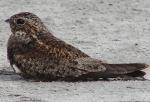
|
Antillean Nighthawk
|
Overview
Antillean Nighthawk: Large nightjar, buff to pale cinnamon-brown overall with fine, dark bars and conspicuous white throat. White patches on long, pointed wings visible in flight. Tail is long, slightly notched with white subterminal tail band. Bill is tiny, bordered with bristles. Mothlike flight, frequent changes of direction. |
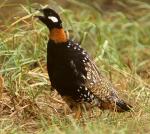
|
Black Francolin
|
Overview
Black Francolin: Introduced to Hawaii in 1959, male has a black breast, and flanks with white spots, belly is rufous. Black head with rufous collar, brown crown and white cheek patches. Back and wings are brown scalloped. Lower back, rump, and tail black with fine white bars. Orange legs and feet. |

|
Buff-collared Nightjar
|
Overview
Buff-collared Nightjar: Small nightjar, mottled gray-brown upperparts, buff collar that appears lighter on dark throat, pale gray-brown underparts with dark brown bars. Tail is gray-brown with white corners. Legs and feet are black. Flight is silent and bouyant on flicking wing beats. |
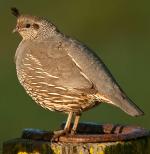
|
California Quail
|
Overview
California Quail: Medium quail with distinctive, curled black head plume and white-bordered black throat. Breast is gray and belly is sharply scaled. The flanks are brown with white streaks and back is olive-brown. Legs and feet are gray. Alternates several stiff, rapid wing beats with short glides. |
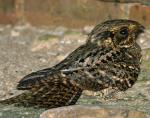
|
Chuck-will's-widow
|
Overview
Chuck-will's-widow: Large nightjar with entire body complexly mottled with brown, gray, and black. Collar is white, throat is brown, and breast patch is dark brown. The tail is white-edged. Legs and feet are brown. Feeds at night, mostly on insects. Bouyant, silent flight with flicking wing beats. |
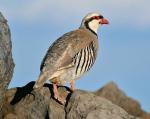
|
Chukar
|
Overview
Chukar: Large, quail-like bird with orange-brown and slate-blue upperparts and breast, and black and rufous barred white flanks. White face has sharp black line extending to neck. Bill and legs are bright pink-red. Escapes danger by running. Direct flight with rapid deep wing beats. |
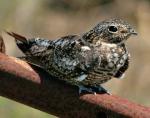
|
Common Nighthawk
|
Overview
Common Nighthawk: Medium nightjar with white-speckled, dark upperparts, black-and-white barred underparts, mottled breast, white throat. Wings are long, dark gray with white bars, nearly covering tail when folded. Gray-brown legs and feet. Darting erratic flight with frequent changes of direction. |
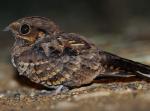
|
Common Pauraque
|
Overview
Common Pauraque: Medium nightjar with dark-streaked, mottled gray upperparts, white throat, black chin, rufous face, pale gray-brown underparts. Wings have brown and black bars, white band at base of primaries visible in flight. The gray tail is long, with dark edges and white patches. |
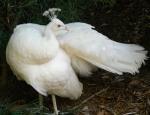
|
Common Peafowl
|
Overview
Common Peafowl: Peacock. Large pheasant with shimmering blue neck and breast. Face is white and head sports a fan-shaped blue crest. During courtship, long ornate tail is fanned out and held erect. Each tail feather has an eye. It forages and nests on the ground but roosts in the top of trees. |
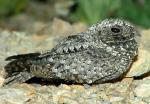
|
Common Poorwill
|
Overview
Common Poorwill: Small, stocky nightjar with pale brown mottled body and white collar separating black throat from narrowly barred underparts. Wings are rounded and tail is short and fan-shaped with outer tail feathers tipped white. Pink-brown legs and feet. Silent flight on quick shallow wing beats. |
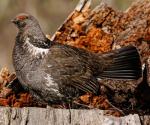
|
Dusky Grouse
|
Overview
Dusky Grouse: Large, chicken-like bird, dark gray to blue-gray plumage, red-orange eye combs, black squared tail with narrow pale gray terminal band. Patch of violet-red skin on neck surrounded by white feathers is displayed during courtship. Formerly (with Sooty Grouse) known as Blue Grouse. |
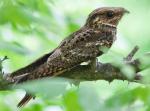
|
Eastern Whip-poor-will
|
Overview
Eastern Whip-poor-will: Medium-sized nightjar with gray-brown-black mottled upperparts and pale gray-black underparts. Throat is black; eyebrows and neckband are white. Tail is long and rounded with large white corner patches. Until recently, this bird and the Mexican Whip-poor-will were combined as the Whip-poor-will. |
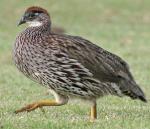
|
Erckel's Francolin
|
Overview
Erckel's Francolin: Introduced to Hawaii in 1957. Gray-brown overall with heavy streaks. Chestnut cap, black eye-stripe and forehead, gray cheeks, light buff to white throat. Gray back, tail and wings have fine brown bars. Black bill, yellow-gray legs and feet. Flight is low and fast. |
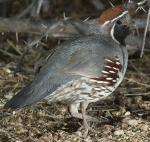
|
Gambel's Quail
|
Overview
Gambel's Quail: Medium quail, gray upperparts and breast, scaled gray nape, black patch on center of abdomen, black head plume, white-bordered black face, cinnamon-brown crown, buff underparts, flanks streaked dark chestnut-brown and white. Alternates several stiff wing beats with short glides. |
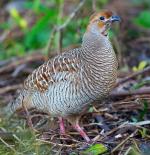
|
Gray Francolin
|
Overview
Gray Francolin: Introduced to Hawaii in 1958. Buff-brown overall with barring, finer on the underparts and heavier on the upperparts. Brown crown, nape. Buff to orange-brown face, cheeks. Buff throat, bordered below by a narrow black stripe. They are fast runners and prefer to run when threatened. |
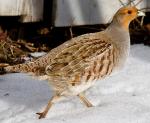
|
Gray Partridge
|
Overview
Gray Partridge: Gray-brown ground bird with rufous face and throat. Body complexly barred and streaked with red and white. Dark red belly patch. Legs and feet are yellow-orange. Prefers to walk rather than fly. Introduced to North America as a game bird in the early 1900s. AKA Hungarian Partridge. |
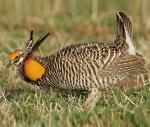
|
Greater Prairie-Chicken
|
Overview
Greater Prairie-Chicke: Medium grouse, barred with brown and buff (or white). Yellow-orange eye combs. Orange air sacs on both sides of the neck inflate during courtship display; long feathers on back of neck also raised during displays. Short, dark brown tail, legs are feathered to the toes. |
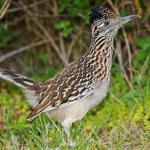
|
Greater Roadrunner
|
Overview
Greater Roadrunner: Large, ground-dwelling cuckoo with overall brown, white and buff streaked appearance. Head has a shaggy crest. Face has blue and orange bare patch of skin behind eyes. Tail is long. Eats insects, lizards, snakes, rodents, small birds and fruits and seeds. Can run up to 15 mph. |
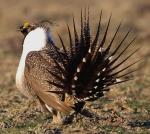
|
Greater Sage-Grouse
|
Overview
Greater Sage Grouse: Largest North American grouse, has scaled gray-brown upperparts, white breast, black throat, bib, and belly, and yellow combs above eyes. Large, white collar-like patch on breast conceals two yellow air sacs displayed during courtship. Tail feathers are long and pointed. |
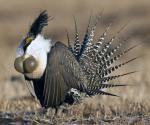
|
Gunnison Sage-Grouse
|
Overview
Gunnison Sage-Grouse: Recognized as a species in 2000. Large grouse, mottled gray-brown overall with white breast, black face, chin, throat, bib and belly. Black bill. Yellow eye combs and long black filoplumes on neck show when courting. Brown tail feathers are long and pointed, with white bands. |
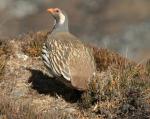
|
Himalayan Snowcock
|
Overview
Himalayan Snowcock: Very wary ground dweller, white face, throat outlined with chestnut stripes, brown collar around neck, gray-brown overall, tan streaked upperparts, white undertail coverts, gray bill, orange-red feet and legs. Flies down mountain each morning, walks back up, eating as it goes. |
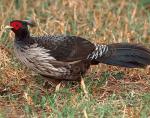
|
Kalij Pheasant
|
Overview
Kalij Pheasant: Native to India and Pakistan. Glossy blue-black overall, face has bright red wattles. Crest, breast, and sides have long white to gray-brown feathers. Feathers from mid-back to rump edged in white, giving a scalloped appearance. Tail is long and black. Legs and feet are light tan. |
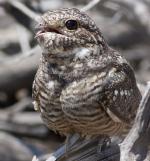
|
Lesser Nighthawk
|
Overview
Lesser Nighthawk: Medium-sized nightjar with gray and white mottled upperparts, white throat, and brown and white mottled underparts with dark belly bars. Wings are dark with conspicuous pale patches visible in flight. Tail is dark brown and has thin white bars across top. Darting erratic flight. |
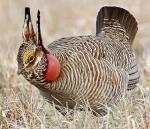
|
Lesser Prairie-Chicken
|
Overview
Lesser Prairie-Chicken: Medium, stocky grouse, brown overall with fine white bars. Head has yellow-orange combs over eyes, plumes that can be raised or laid along the neck. Red-orange air sacs on sides of neck inflate during courtship. Tail is short, black, and rounded. Yellow-brown feathered legs. |
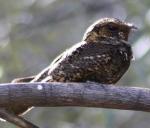
|
Mexican Whip-poor-will
|
Overview
Mexican Whip-poor-will: Medium-sized nightjar with brown-gray-black mottled upperparts and pale gray-brown underparts. Throat is black; eyebrows and neckband are white. Tail is long and rounded with white corner patches. Until recently, this bird and the Eastern Whip-poor-will were combined as the Whip-poor-will. |
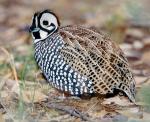
|
Montezuma Quail
|
Overview
Montezuma Quail: Odd, plump quail with short tail, complexly buff-barred and streaked dark upperparts, and heavily white spotted dark underparts divided by a wide rufous-brown stripe from breast to tail. Face is boldly patterned black and white; head has a rounded light brown crest. |
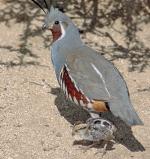
|
Mountain Quail
|
Overview
Mountain Quail: Large,striking quail with long elegant black head plume, white-bordered rufous-brown face and throat, gray-brown upperparts, blue-gray breast, and rufous-brown belly and sides with distinct white bars. Rapid direct flight, series of several stiff wing beats followed by a short glide. |
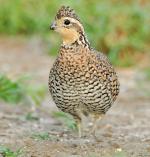
|
Northern Bobwhite
|
Overview
Northern Bobwhite: Medium, morphologically variable quail, most with unique head pattern of white face and throat, dark eyestripe, rufous-brown (eastern and Great Plains) or black (Florida) center stripe on top of head. Body shows a mottled combination of black, brown, rufous-brown, and gray. |
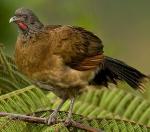
|
Plain Chachalaca
|
Overview
Plain Chachalaca: Loud, phesant-like bird. Drab in color with gray head, olive-brown back, buff belly, dark tail with green gloss. Male shows bright red gular stripe during courtship displays. Feeds on insects, fruits, berries, seeds, leaves and buds. Alternates rapid stiff wing beats with glides. |
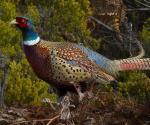
|
Ring-necked Pheasant
|
Overview
Ring-necked Pheasant: Large, chicken-like pheasant with metallic-brown body, iridescent green head, white neck ring, and bright red eye patch and wattles. The tail is very long and pointed. It was first introduced to California from Asia as a game bird in 1857. Very popular bird for hunting. |
|
|